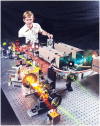Coherent Raman scattering microscopy: capable solution in search of a larger audience
- PMID: 34085436
- PMCID: PMC8174578
- DOI: 10.1117/1.JBO.26.6.060601
Coherent Raman scattering microscopy: capable solution in search of a larger audience
Abstract
Significance: Coherent Raman scattering (CRS) microscopy is an optical imaging technique with capabilities that could benefit a broad range of biomedical research studies.
Aim: We reflect on the birth, rapid rise, and inescapable growing pains of the technique and look back on nearly four decades of developments to examine where the CRS imaging approach might be headed in the next decade to come.
Approach: We provide a brief historical account of CRS microscopy, followed by a discussion of the challenges to disseminate the technique to a larger audience. We then highlight recent progress in expanding the capabilities of the CRS microscope and assess its current appeal as a practical imaging tool.
Results: New developments in Raman tagging have improved the specificity and sensitivity of the CRS technique. In addition, technical advances have led to CRS microscopes that can capture hyperspectral data cubes at practical acquisition times. These improvements have broadened the application space of the technique.
Conclusion: The technical performance of the CRS microscope has improved dramatically since its inception, but these advances have not yet translated into a substantial user base beyond a strong core of enthusiasts. Nonetheless, new developments are poised to move the unique capabilities of the technique into the hands of more users.
Keywords: coherent Raman scattering microscopy; lipid metabolism; optical imaging.
Figures


References
-
- Duncan M. D., “Molecular discrimination and contrast enhancement using a scanning coherent anti-Stokes Raman microscope,” Opt. Commun. 50(5), 307–312 (1984).OPCOB810.1016/0030-4018(84)90173-1 - DOI
-
- Duncan M. D., Reintjes J., Manuccia T. J., “A review of the NRL CARS microscope,” AIP Conf. Proc. 160(1), 631–637 (1987).10.1063/1.36835 - DOI
-
- Zumbusch A., Holtom G. R., Xie X. S., “Three-dimensional vibrational imaging by coherent anti-Stokes Raman scattering,” Phys. Rev. Lett. 82(20), 4142–4145 (1999).PRLTAO10.1103/PhysRevLett.82.4142 - DOI

